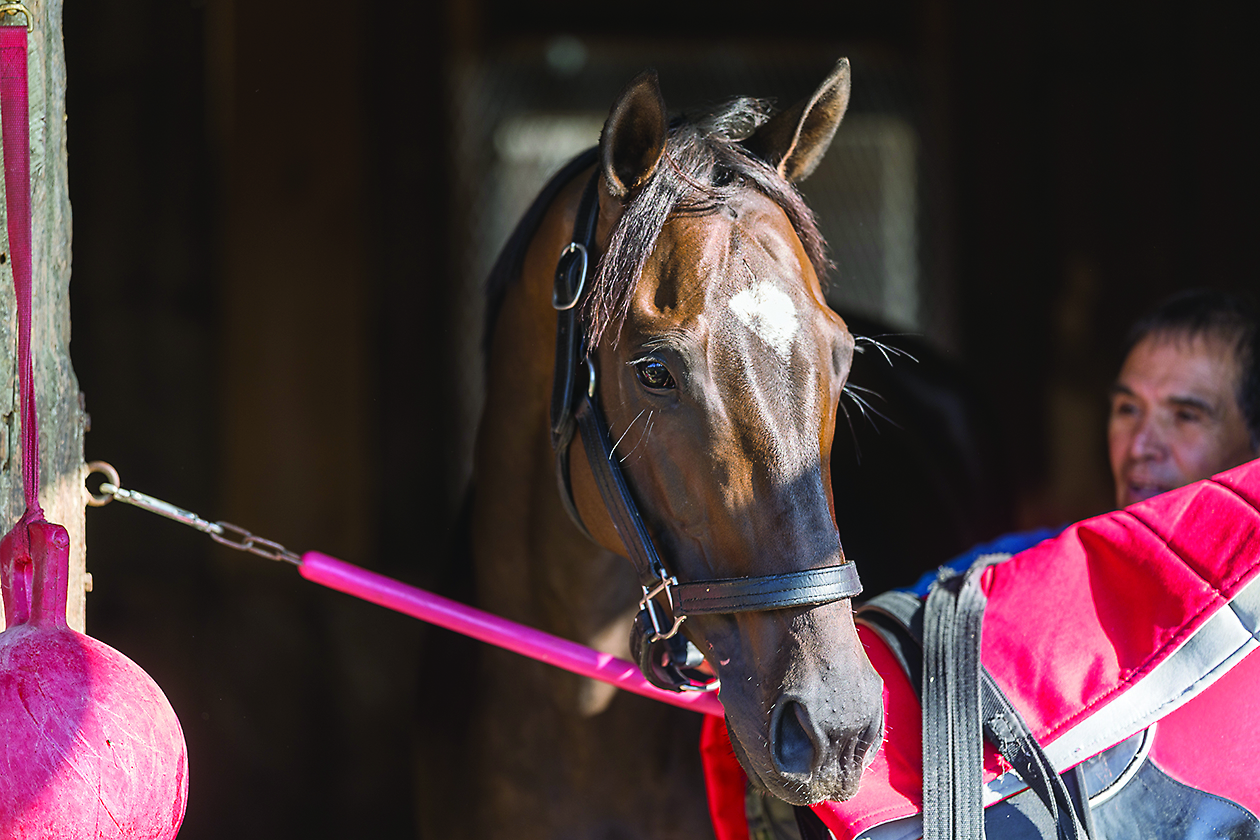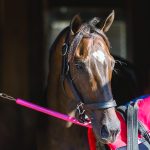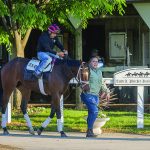
his first of two wins at the Cheltenham Festival that year.
Press Association/ Maryland Horse archives
In racing’s current climate of win percentages, instant criticism, training for peak efforts and the generally-agreed-upon-if-difficult-to-prove thought that Thoroughbreds aren’t as hardy as they once were, trainer Dan Moore’s decision to run American horse Inkslinger twice in three days at the 1973 Cheltenham Festival seems implausible.
“Nowadays, with all the technology and feeding them and things the times are the same as they were 20-30 years ago,” said veteran Irish trainer Arthur Moore, Dan’s son and former assistant who helped prep Inkslinger. “It just proves the point. Horses were tougher-bred then than they are now.”
The closest thing United States jump racing had to Cheltenham or any multi-day meeting was the Rolling Rock Races in Ligonier, Pa. The October meet (last run in 1983) included racing on Wednesday and Saturday, with horses spending most of the week there. They didn’t all races on both days, but it was a regular occurrence.
Soothsayer won twice at Rolling Rock during his 1972 championship campaign. In 1983, three horses who won races on Wednesday met in the feature on Saturday – and finished 1-2-3 (Sugar Bee over Fabulous Time and Spouting Creeque).
Spring timber horses still frequently race twice in seven days or even three times in 14 days. As Moore did with Inkslinger, trainers work up to such a demanding schedule.
“When I’ve run my timber horses back from one week to the next, they ran the best when they were just were a hair short over the last fence the first time and didn’t quite get there,” said trainer Todd Wyatt. “After that hard race, it just sets them up for running back in a week. To have a great effort to win and to come back and have another great effort and win again is hard.”
Nevertheless, Wyatt admires the idea of tackling two races the way Moore did with Inkslinger.
“They probably knew they were going to do that a long way out,” he said. “They didn’t win on Tuesday and say, ‘Oh, let’s run him on Thursday.’ I’d think they had that plan well before he ran in the Tuesday race and would have changed third minds if something didn’t work out with the horse in the first race.”
Last year, Wyatt ran hurdle horse State Of Affair back in two weeks twice, not exactly Inkslinger territory but a quick turnaround by some standards. In May, he was second at the Virginia Gold Cup and third at Radnor two weeks later. The move paid off at Saratoga as State Of Affair finished fifth July 27 and came back and won Aug. 10, shipping home to Maryland in between.
“I’m the most conservative guy in the world because the first thing I think about after they win is that I want to give them six weeks off,” he said. “You have to be prepared to not run. When a good trainer does something that seems unorthodox, they say the horse took them there. I think you can tell when people are throwing paint at the wall. When I have tried to do it, it doesn’t seem to always work out but when it does, it’s when the horse took me into that position, the horse just kind of dragged me there. When I do it with a horse I hadn’t thought of doing it with, it rarely works out.”
The conundrum trainers face, Wyatt said, is that the decision to run isn’t necessarily based on a horse’s physical well-being.
“You’re not getting them any fitter, it’s a mental thing,” he said. “Those horses know what you’re doing.”
Like Wyatt, Mark Beecher marveled at Inkslinger’s feat before mulling what it would be like to train such a horse.
“He must have been a hell of a horse,” Beecher said. “To do that in three days, it wouldn’t have been easy. I’d presume their main goal was the Queen Mother and they had him entered in the Cathcart as back-up, but he probably came out of the first race bouncing and they said, ‘Well, we’re here. We’ve got nothing to lose now,’ and he went out and did it. He was probably that good that he only had a workout in the Queen Mother and he was able to go and win Thursday.”
As for trying such a thing, Beecher paused to think about the Thoroughbreds in his barn or available to put in his barn.
“He’d want to be some machine,” he said. “The good horses, they’re good by themselves. It’s the lesser ones that need the training.”
Inkslinger and the other American success stories (Jay Trump, Ben Nevis, Soothsayer, Fort Devon, Tingle Creek, Lonesome Glory) were not lesser horses. Taking a U.S. steeplechase horse to England or Ireland would be akin to taking an Irish hockey team to a tournament in Canada. You better bring your best skaters.
“I don’t think there’s as big of a gap as everyone believes there to be, but you’d want to go with a good horse,” said Beecher. “You have to have a very good horse to go and take them on. There are so many horses over there, that’s probably it as much as anything. The group of horses is so much larger so the group of good horses is larger too. Those big trainers have three or four horses each for those races.”
Numbers matter here, too, as a trainer with fewer horses would be less likely to risk one to a quick turnaround.
“If you don’t have many horses, you’re thinking about making them last all the time, about keeping them in training and getting three, four, five races out of them,” Beecher said. “No trainer wants to get their horse hurt or to have something happen, but people with not many horses will find it harder to do. If you have two or three horses ready to come into that stall, it’s a bit easier to think that way.”
Trainer Kate Dalton laughed when asked if she’d ever contemplated running a horse twice in three days.
“I must have run something back a week later, at least once in my life,” she said. “I really like three weeks especially if there’s shipping involved. If you didn’t ship, it would be easier.”
Inkslinger shipped from Ireland to England for the Festival, but stayed at the racecourse between starts. Like their European counterparts, American steeplechasers spend plenty of time on the road traveling to each meet. The trip might be an hour or two, or a longer trek to more remote race meets. Based in Camden, S.C., Dalton’s horses travel easier to Aiken, Camden, Charlotte, Charleston and other southern stops compared to the roughly 900 miles to Saratoga.
“I always think it’s the ship home, after they run, that wears them out,” she said. “I think you can get away with the ship to the races, because of the adrenaline. When you run, then put them on a van and ship home, they’re tired when they get home.”
Dalton had little trouble thinking of a horse in her past who might have handled Inkslinger’s schedule.
“Sundin could have handled it,” she said of six-time steeplechase winner trained by her former boss Jonathan Sheppard. “He galloped every day and if you didn’t have the right person, he ran off every day. And it never slowed him down. He’d run off or have a strong gallop today and go out and do the same thing tomorrow. He could have run back in three days and it would not have been a bother on him.”
Sheppard, of course, trained Inkslinger during his in 1970 before the Maryland-bred shifted to Mikey Smithwick’s barn the following season. Trainer Janet Elliot, a Sheppard staffer in 1970, called Inkslinger an exceptional horse.
“Right off the bat, he was a very nice horse,” she said. “You don’t go abroad unless you think you’ve got something worth taking. He was a young horse, too. That had to help. He won six races – six – as a 3-year-old.”
Elliot ran a horse on back-to-back days in 2014. Irish-bred (naturally) Floating Ballerino finished sixth going 5 furlongs at Delaware Park Sept. 10 and the next day placed third going 5 1/2 at Laurel Park.
“People were like, ‘What are you doing?’ ” she said. “That’s a very short distance and people were doing it going 2 miles and so on in Europe. To me that sort of thing isn’t a surprise. If the animal is fit and in good shape, why wouldn’t you?”
Like others, Elliot said a horse’s response to the first race would dictate whether you run back on short rest.
“It entirely depends on the horse,” she said. “Is he doing well, eating well, staying good and sound? The ones that come back from a race and don’t eat for four days you wouldn’t be inclined to do it.”
Of her standout steeplechase horses, she pointed to Flat Top as an ideal candidate for an Inkslinger-like attempt.
“It’s attitude more than anything and he had it,” she said of the two-time champion. “He could just handle the racing and was tougher, kind of different, than some horses. I remember bringing him to Camden one year and he lived in Bobby Sloan’s van before the race. He was a bad stall walker and Camden didn’t suit him. We put him in a box stall on one side and a pony for company in a box stall on the other side. That worked for him.”
Flat Top never ran twice in three days, basically impossible given the U.S. steeplechase schedule. Elliot kept plenty of others busy during a Hall of Fame career including Spouting Creeque (a win and a third at Rolling Rock Sept. 14 and 17, 1983); Bomb (four starts, three wins, in April 1983); and Ask Don (last of nine on the dirt at Pimlico May 16, 1992 and a winner four days later on the turf at Belmont Park).
“Nowadays for some reason it seems to be so out of the ordinary, and I don’t know what the difference is,” she said of busier campaigns. “I guess it’s the people. I suppose we probably spend too much time trying to run too fast. Then, I think you kept on going steadily along rather than the speed we have now. That’s the way people train now.”








